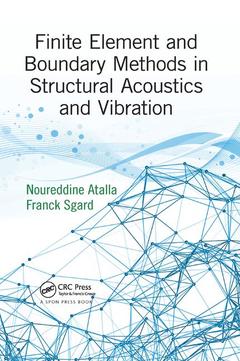Description
Finite Element and Boundary Methods in Structural Acoustics and Vibration
Authors: Atalla Noureddine, Sgard Franck
Language: English
Subjects for Finite Element and Boundary Methods in Structural...:
Keywords
Exterior Problem; Galerkin’s Weak Formulation; Boundary Element Method; Mixed Finite Element Method; Collocation Method; Exterior Domain; Computational Vibroacoustics; BEM; Elastic Sphere; Dp Dx; Strong Integral Formulation; Added Mass Matrix; Fem-Vbem Approach; Acoustic Pressure; Fem-Vbem Coupling; Coupled System; Baffled Circular Piston; Plane Wave; Linear Acoustics; Poroelastic Material; Linear Elastodynamics; Fluid Domains; Linear Poroelasticity; Nodal Vector; Coupled Fluid-Structure Problem; Porous Material; Poro-Elasto-Acoustic Coupling; Structural Acoustics; Fem-Bem Coupling; BEM Mesh; Weak Integral Formulation; Quadratic Elements; Stationarity Principle; Trial Functions; Principle Of Virtual Work; GPa Poisson’s Ratio; Semianalytical Approach; Petrov Galerkin’s Method; Sound Package; Semi-analytical Approach; Dynamic Bulk Modulus
89.57 €
In Print (Delivery period: 14 days).
Add to cartPublication date: 07-2017
· 15.6x23.4 cm · Paperback
256.94 €
In Print (Delivery period: 15 days).
Add to cartPublication date: 04-2015
· 15.6x23.4 cm · Hardback
Description
/li>Contents
/li>Biography
/li>
Effectively Construct Integral Formulations Suitable for Numerical Implementation
Finite Element and Boundary Methods in Structural Acoustics and Vibration provides a unique and in-depth presentation of the finite element method (FEM) and the boundary element method (BEM) in structural acoustics and vibrations. It illustrates the principles using a logical and progressive methodology which leads to a thorough understanding of their physical and mathematical principles and their implementation to solve a wide range of problems in structural acoustics and vibration.
Addresses Typical Acoustics, Electrodynamics, and Poroelasticity Problems
It is written for final-year undergraduate and graduate students, and also for engineers and scientists in research and practice who want to understand the principles and use of the FEM and the BEM in structural acoustics and vibrations. It is also useful for researchers and software engineers developing FEM/BEM tools in structural acoustics and vibration.
This text:
- Reviews current computational methods in acoustics and vibrations with an emphasis on their frequency domains of applications, limitations, and advantages
- Presents the basic equations governing linear acoustics, vibrations, and poroelasticity
- Introduces the fundamental concepts of the FEM and the BEM in acoustics
- Covers direct, indirect, and variational formulations in depth and their implementation and use are illustrated using various acoustic radiation and scattering problems
- Addresses the exterior coupled structural?acoustics problem and presents several practical examples to demonstrate the use of coupled FEM/BEM tools, and more
Finite Element and Boundary Methods in Structural Acoustics and Vibration utilizes
Introduction. Basic equations of structural acoustics and vibration. Integral formulations of the problem of structural acoustics and vibrations. The finite element method: An introduction. Solving uncoupled structural acoustics and vibration problems using the finite-element method. Interior structural acoustic coupling. Solving structural acoustics and vibration problems using the boundary element method. Problem of exterior coupling. Conclusion. References.
Noureddine Atalla is a professor in the Department of Mechanical Engineering (Université de Sherbrooke). He is also a member and past director of GAUS (Group d’Acoustique et de vibration de l’Universite de Sherbrooke). Professor Atalla received an MSC in 1988 from the Université de Technologie de Compiègne (France) and a PhD in 1991 in ocean engineering from Florida Atlantic University (USA). His core expertise is in computational vibroacoustics and modeling and characterization of acoustic materials. He has published more than 100 papers and is also the co-author of a book on the modeling of sound porous materials.
Franck Sgard




